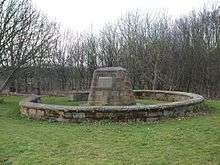Battle of Roslin
| Battle of Roslin | |||||||
|---|---|---|---|---|---|---|---|
| Part of the First War of Scottish Independence | |||||||
 Battle of Roslin memorial | |||||||
| |||||||
| Belligerents | |||||||
|
|
| ||||||
| Commanders and leaders | |||||||
|
John III Comyn, Lord of Badenoch and Guardian of Scotland |
Ralph Manton Sir William Latimer or Sir Robert Neville | ||||||
| Casualties and losses | |||||||
| unknown | unknown | ||||||
The Battle of Roslin was a battle of the First War of Scottish Independence. It took place near the village of Roslin, Midlothian on 24 February 1303.
Background
An Anglo-Scottish truce expired on 30 November 1302, and the English prepared for a fresh invasion of Scotland, with John Segrave as the king's lieutenant in Scotland. King Edward ordered Segrave to carry out a large-scale reconnaissance as far as Kirkintilloch, before the king himself fought a larger campaign. This force assembled at Wark on Tweed and moved north.[1]
The Battle
The English advanced in three divisions, harassed by the Scots. At night they camped in three divisions, several miles apart. The two commanders, John III Comyn and Simon Fraser, led a Scots force on a night march, fell on the English, capturing Segrave and several others. Robert Neville led his division towards the action. The English eventually freed Segrave, but the English paymaster Manton was killed.[2].
Later legend
The Scottish historian John of Fordun wrote an exaggerated description of the fight:
...there never was so desperate a struggle, or one in which the stoutness of knightly prowess shone forth so brightly. The commander and leader in this struggle was John Comyn, the son... But John Comyn, then guardian of Scotland, and Simon Fraser with their followers, day and night, did their best to harass and to annoy, by their general prowess, the aforesaid kings officers and bailiffs... But the aforesaid John Comyn and Simon, with their abettors, hearing of their arrival, and wishing to steal a march rather than have one stolen upon them, came briskly through from Biggar to Rosslyn, in one night, with some chosen men, who chose rather death before unworthy subjection to the English nation; and all of a sudden they fearlessly fell upon the enemy.
The battle was the subject of a fictional account written by Walter Bower in the mid-15th century. Like Fordun, Bower seriously exaggerated its size and importance. The distorted impression of Roslin has lingered in the public imagination to this day.
A monument cairn erected by the Roslin Heritage Society at the end of the 20th century marks the site of the battle. At the start of the 21st century the battlefield was under research to be inventoried[4] and protected by Historic Scotland under the Scottish Historical Environment Policy of 2009.
References
- ↑ Traquair pp. 110-111
- ↑ Traquair p. 111
- ↑ John of Fordune's Chronicle of the Scottish Nation pages 326-327
- ↑ "The Inventory of Historic Battlefields - Battle of Roslin" (PDF). Retrieved 2013-10-07.
- Scottish Battlefields, (tempus/History Press), 2006
- A.D.M. Barrell, Medieval Scotland, (Cambridge University Press)
- Peter Traquair Freedom's Sword, (HarperCollins 1998)
- Michael Brown, The Wars of Scotland, 1214-1371 (Edinburgh, 2004)